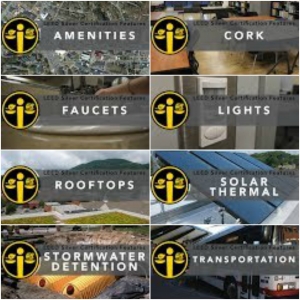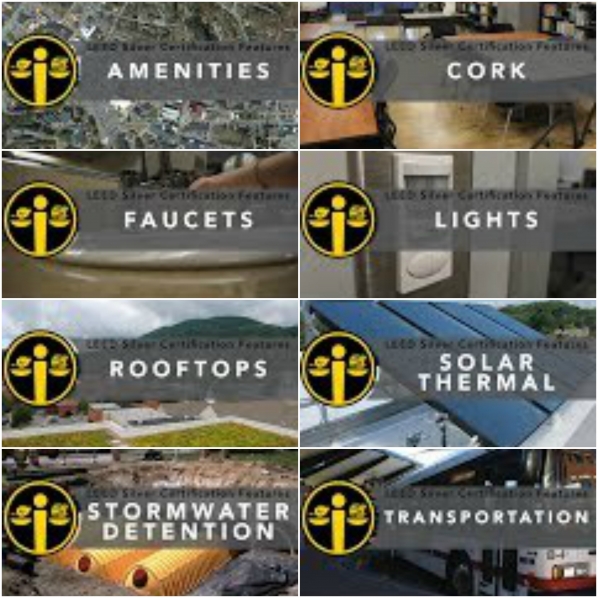Dr. Rachel Wilson’s CI 3552 Environmental Literacy fall 2017 class produced a series of videos about sustainability in the Reich College of Education (RCOE).
Wilson assigned this project because the RCOE building is LEED Silver Certified and has features that make it unique including the small footprint it is leaving on the environment.
According to the U.S. Green Building Council:
LEED (Leadership in Energy and Environmental Design) is the most widely used green building rating system in the world. Available for virtually all building project types, from new construction to interior fit-outs and operation & maintenance, LEED provides a framework that project teams can apply to create healthy, highly efficient, and cost-saving green buildings. LEED certification is a globally recognized symbol of sustainability achievement.
Projects pursuing LEED certification earn points across several categories, including energy use and air quality. Based on the number of points achieved, a project then earns one of four LEED rating levels: Certified, Silver, Gold or Platinum.
For this assignment, in a group of two or three, students choose from a list of aspects that make our RCOE building Silver LEED certified. They researched why, including how that building aspect is considered "green building design" and how it lessens the impact of the building on the surrounding environment. Students took their own photos, videos, and developed their own narration to create an educational video. Topics include: amenities within walking distance, cork flooring, low-flow sink faucets, LED light bulbs, the rooftop garden, the solar hot water heater, underground stormwater detention and access to public transportation.
Amenities Within Walking Distance
One reason why this building is LEED Silver Certified is because it is so close to many amenities in downtown Boone.
There are many amenities that are within walking distance from the Reich College of Education, such as Earth Fare, Our Daily Bread, Boone Drug and the fire department. By having these amenities so close, people can park, then walk, which cuts down the fossil fuels on the environment.
Adjusting fossil fuels that are being used, the local community will have better air quality. The closer these amenities are, the less gas will be used, which reduces the fossil fuels in the atmosphere. With this information gained, we hope that you apply it to your daily life by walking, rather than driving, somewhere that is close.
Cork Flooring
Did you know that there is cork flooring in the building, which falls under the materials and resources category?
Cork comes from the bark of cork oak tree. These trees can be found in Italy, Portugal, Morocco, and Spain. Because it comes from trees, cork is a renewable resource. Cork is an excellent insulator, so by using cork in the RCOE, we reduce the amount of energy needed to heat the building.
Low Flow Faucets
These faucets have sensors in them and when your hands brush across them, the water immediately turns on, or off. This leads us to be able to use less water when we’re washing our hands.
This water reduction has allowed for more water to stay in the watershed and benefits the community and habitats that rely on the water as well. Using less water via the sink faucets helps keep energy costs down and it helps to keep the water where it was intended to be: with the plants and animal habitats that need it. Using less water proves to our campus that we are committed to sustainability. Students, faculty, and visitors alike all can have a part in making the community more sustainable.
LED Lights
The RCOE has features such as LED lights on the interior and exterior, dimmers, and occupancy sensors to conserve energy. The LED light bulbs in the building only use about 25% of the energy consumed by a regular, incandescent light bulb and can last 25 times as long. Dimmers save energy and increase the lifespan of bulbs, and occupancy sensors turn off the lights for you when you’re leaving the room.
Rooftop Garden
Did you know that the RCOE has a rooftop garden?
The rooftop garden insulates the building, so less energy is being used to heat and cool the building. The RCOE uses a natural source as an insulator for the building as opposed to a nonrenewable source like coal and gas, which are the current energy suppliers around the town.
Solar Hot Water Panels
Hot water solar panels reduce our environmental footprint by decreasing the need for hot water heaters, which are fossil fuel based.
By using solar energy, the amount of greenhouse gas emissions in the area can significantly reduce. This is a good thing, for fossil fuels and greenhouse gases cause global warming and climate change.
Stormwater Detention
RCOE has an underground stormwater detention, which reduces risk of the building and surrounding areas from flooding. When it rains, the water flows into the underground stormwater detention, where it is stored. Over time, it slowly discharges water so that it does not overwhelm the drainage infrastructure.
The stormwater detention helps to keep the community looking nice and saves money by making sure that the ground is not overwhelmed with a bunch of water at once.
Public Transportation
By taking public transportation to the Reich College of Education, like AppalCart, you can save gas because you are not driving your own car to campus. AppalCart buses drop passengers off right in front of the RCOE.

